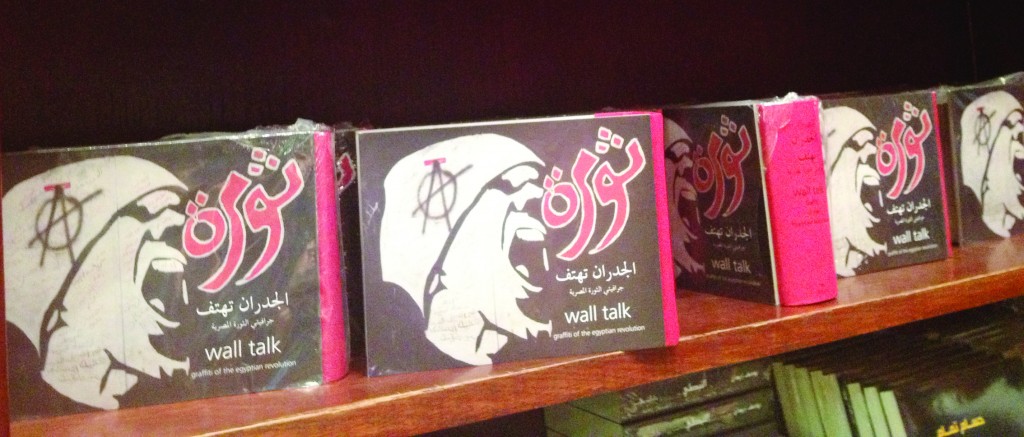 People packed the Shorouk bookstore on Tala’at Harb Square on Saturday night in anticipation of the launch for Wall Talk: Graffiti of the Egyptian Revolution. The 680 page book depicts hundreds of pieces of Egyptian street art, collected over the months during Egypt’s uprising and following transitional period in striking colour. The book also provides accounts of events during almost every day over a year and a half year time span, beginning with the church bombing in Alexandria on 1 January 2011 and ending on 30 June 2012, when Mohamed Morsy was sworn in as the new president of Egypt.
People packed the Shorouk bookstore on Tala’at Harb Square on Saturday night in anticipation of the launch for Wall Talk: Graffiti of the Egyptian Revolution. The 680 page book depicts hundreds of pieces of Egyptian street art, collected over the months during Egypt’s uprising and following transitional period in striking colour. The book also provides accounts of events during almost every day over a year and a half year time span, beginning with the church bombing in Alexandria on 1 January 2011 and ending on 30 June 2012, when Mohamed Morsy was sworn in as the new president of Egypt.
The group launching the book stressed that it was a collaborative effort, between the artists who created the graffiti, the photographers who captured it, and those who found the graffiti before it was erased.
The book launch occurred two days after government officials painted over the walls of Mohamed Mahmoud Street, home to some of Cairo’s most celebrated, renowned and iconic street art. The erasure of the graffiti and the following initiative by street artists to create new messages further emphasised the importance of books like Wall Talk. “It upsets me when my art is erased,” said Ammar Abo Bakr, an artist with many of his creations featured in the new book, “but knowing that our graffiti is recorded is enough for us.” With the disappearance of street art however comes an opportunity for him and fellow artists to concoct more topical creations that speak to the problems that currently exist in what has become a fluid political situation in Egypt.
Malek Mostafa, who wrote a foreword to the book, told those attending the launch that the goal of the book was to remind all those who read it to move forward from what had taken place over the last year and a half. He drew parallels between Egypt’s revolution and its graffiti movement. Both were self-motivated phenomena in which people worked with each other on the same level, rather than large parties or powerful people mobilising them.
“It’s not just about graffiti,” said Sherif Boraie, who edited the book. “It’s a chronicle of our revolution. It’s about our angst.”
While graffiti did exist before Egypt’s revolution, it was relatively undeveloped and did not play even a small fraction of the role it does today. The book powerfully illustrates the evolution of Egypt’s graffiti into a blossoming form of art, with its own identity, and very importantly, captures those pieces of art that have been painted over on various occasions.
Although the creators of the book made electronic copies available for free online, the profits of hard copies of Wall Talk go to Mosireen, a collaborative media effort that has recorded events throughout Egypt’s revolution.
When the launch ended the crowd, which had grown too large for the small shop to accommodate, turned its focus to rapper Aly Talibab, whose politically charged lyrics coupled with dynamic instrumentals drew people to the stage assembled at the opposite end of the square.




